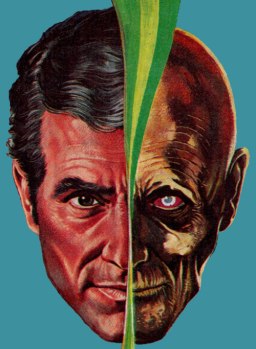Fungi and toadstools and shrooms, oh my!
Murray Leinster’s novella, The Mad Planet, has been reprinted quite a few times after if first appeared in the 12 June, 1920 issue of Argosy, most recently in 2015. This longevity surprises me not at all because even today The Mad Planet remains a fascinating look at a suitably alien future Earth.
The single best reprint appeared in the November 1948 issue of Fantastic Novels Magazine. No so much for the Virgil Finlay action cover (which I personally don’t care for) but rather the magnificent full-page black and white illustration with which Finlay attempted to give the reader some idea of what Leinster’s future world looked like.
Finlay’s art style is well suited to illustrating this sort of lush future world, so much so that I felt it was a pity that the drawing was in black and white and decided to do something about it. Adding colour does somewhat reduce the amount of texture the black and white version has but I think the added richness more than compensates for that. Not perfect perhaps but I’m still quite pleased with the result.

The Mad Planet was the first in a series of stories Leinster wrote about life on Earth 30,000 years in the future. In this first story story it’s revealed that dramatically changed climatic conditions had been caused by a massive increase in the amount of carbon dioxide in Earth’s atmosphere. Leinster explained that this increase was party due to human activity which lo these many years later seems particularly prophetic. Apparently though he wasn’t able to believe that humanity alone would be capable of causing the degree of change his plot required so he also had holes opening up in the Earth’s crust to release even more carbon dioxide. (I’ve been told that something similar to Leinster’s holes is scientifically plausible in that it has been speculated that the melting of the permafrost might release considerable quantities of carbon dioxide into the atmosphere.) Leinster then postulated that this change in the atmosphere resulted in fungal and insect life flourishing and growing to enormous size while nearly every other form of life other than man and fish died out. The story is well worth a read for anybody who doesn’t suffer from arachnophobia.

At a distance of six feet I would have guessed the artist is Ian Miller, mostly because of the colours. In frozen tundra is not carbon dioxide but, I think, methane. Methane is orders greater a greenhouse gas. CO2, methane, regardless, let us hope for our planet’s tundra to stay frozen, for Leinster’s sake.
LikeLike